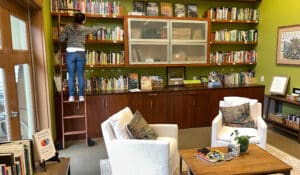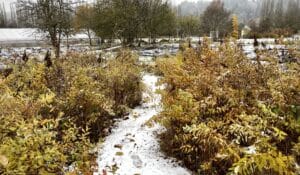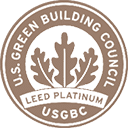
Seeds of Equity in the Green Building Movement
Seeds of Equity in the Green Building Movement
- posted on: September 16, 2020
- posted by: Rebecca Jordan
"*" indicates required fields

Hi all—Barry Febos here, Energy Manager & Educator at 21 Acres.
Sustainable design has three central principles: Environment, Economy, and Equity, meaning that at its foundation, the sustainable building movement is an intersectional movement. This means it has a unique capacity to address converging social, economic, and environmental problems as they relate to buildings and the building industry. The COVID-19 public health crisis has worsened an already deep housing crisis and brought on a recession, all of which amplify endemic inequities along lines of race and class in our society.

All of this unfolds within the context of a rapidly changing climate that is likely to further compound these inequalities throughout the world. The movement for climate justice brings together all of these concerns. I believe that green building has an important role to play. Many projects nationally and locally are greening affordable housing, inviting community leadership, and bringing more diverse voices to the industry.
The seeds of this movement are sprouting up around us and with enough public support and resources they could rapidly grow into a thriving green and equitable economy. This post highlights some of the most relevant and encouraging manifestations locally and beyond that I have recently come across.
National push for green building equity strikes a local chord
On a national level, the NAACP recently began an initiative to foreground equity in sustainable building and has published a report entitled: “Getting Beyond Green” on equity requirements in green building standards. I was excited to find that 3 of the 15 equity–containing standards reviewed in the report happen to be based quite locally. The Living Building Challenge, Built Green, and the King County Sustainable Infrastructure Scorecard are all based in and around King County. I also became aware of a new equity–focused certification known as the Enterprize Green Community Criteria which is a unique national green building program designed explicitly for affordable housing.
Creative resilience in Seattle
I want to highlight a few exciting local projects that I feel exemplify this kind of work. During last year’s Living Future conference, I was fortunate to be able to take a tour with Seattle’s Block project. The Block Project is a pioneering grass-roots Seattle based effort that pairs local homeowners with unhoused community members and a team of designers, builders, and social workers to create long–term housing opportunities in backyards throughout the city. All Block homes are solar–powered and working toward giving back more energy than they use.
Another related program called Sawhorse Revolution pairs architects and builders with diverse teams of high school students to complete community design/ build projects including tiny homes for unhoused neighbors using recycled materials, solar power, and rainwater catchment. These projects exemplify the inspiring level of engagement and community building that can come from approaching social crises as opportunities for creative resilience.
Building green community
I also had the opportunity to connect with Denise Henrikson during a community event last year who is one of the organizers of Eco-thrive, an exciting organization working to develop ecologically-minded and cooperatively owned affordable housing communities, starting with a pilot project in King County. Eco–thrive has inspiring community designs and has helped to pass an interim zoning ordinance to pave the way for their deeply affordable development model based on community land trusts and cooperative ownership.
Just to our north, HopeWorks Station II is a great representation of all of the intersectional benefits green building can offer when equity is foregrounded. Based two blocks from the Everett transit center, the project works with unhoused and low-income community members to provide housing and job-skills training through eight different onsite social enterprises. HopeWorks Station II is also the first LEED Platinum certified building in Everett and is poised to achieve the Energy Petal of the Living Building Challenge, producing more energy than it uses through extensive solar installations. The project is also one of four in Washington to receive state funding through the Ultra-High Energy Efficient (UHEE) Affordable Housing Demonstration Program.
In Whatcom county, Habitat for Humanity is building a new super-efficient low-income housing development and has partnered with a local solar installer to fund solar installations for the community. This project will create 54 new high-efficiency affordable homes and provide low-income residents an accessible path to home ownership for each one. Many of the habitat homes are designed to be “net-zero ready” as well, meaning that with added solar panels they can achieve net-zero. A net-zero energy home consumes only the amount of energy that it is able to produce with renewable energy over the course of a year.
Not far off in Bellingham, TC Legend Homes LLC, built the pioneering Cedarwood net-zero energy home for only $144 per square foot. This project gained national recognition and took grand prize in the Affordable category at the U.S. Department of Energy’s Housing Innovation Awards. Representatives from TC Legend Homes are presenting at this year’s virtual Built Green conference on Sept 17th.
This Built Green conference will also feature a session on Africatown Plaza, an important example of restorative community-driven design in Seattle’s Central District. In the face of gentrification pressure and skyrocketing local rents, the project works to preserve African American community space, affordable housing and green space in the historically African American neighborhood. The project also seeks to celebrate African cultural heritage and create iconic Afro-centric architecture. The Plaza is a project of the Africatown Landtrust, which purchases land to support the vitality of the Central District’s African American community into the future.
There is still much work to be done to expand the reach and benefits of equitable green design, but I hope this provides some insight into local entry points and change-making projects. With these inspiring examples, we can address the housing crisis from a regenerative design perspective that foregrounds social justice and lifts all boats. For a more in-depth exploration of the local green building movement and to engage in the conversation, check out the up-coming Green Building Slam and Summit from the Northwest Eco-builders Guild.
Learn More: Green Building Equity in King County and Beyond
For local municipal resource pages and national case studies in equitable design, check out the links below.
Municipal green affordable housing resources:
National design equity:
If you’re interested in what Barry has to share and to learn more about his expertise in green energy, join us for a virtual Green Building Tour on the first Saturday of each month at 11am. Details about how to register are here.










 back to blog overview
back to blog overview








